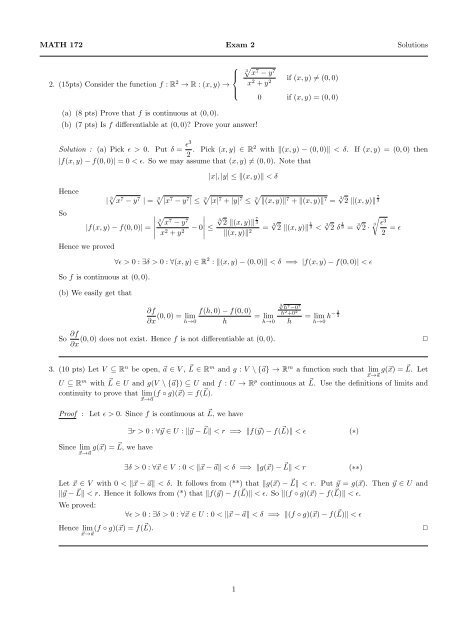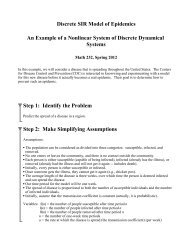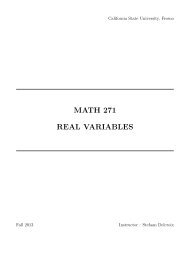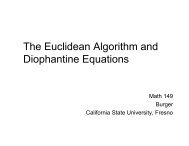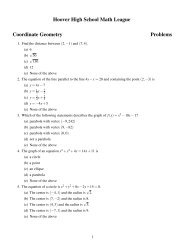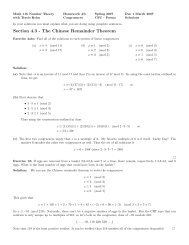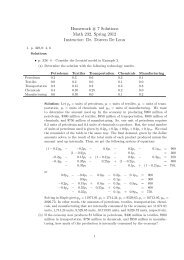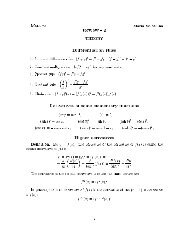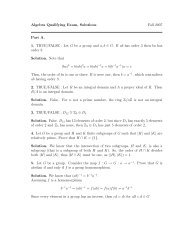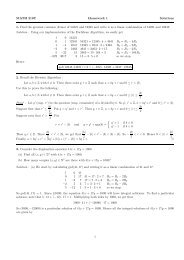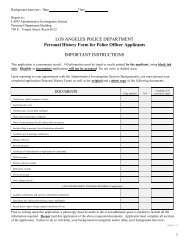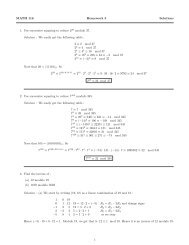MATH 172 Exam 2 Solutions 2. (15pts) Consider the function f : R 2 ...
MATH 172 Exam 2 Solutions 2. (15pts) Consider the function f : R 2 ...
MATH 172 Exam 2 Solutions 2. (15pts) Consider the function f : R 2 ...
You also want an ePaper? Increase the reach of your titles
YUMPU automatically turns print PDFs into web optimized ePapers that Google loves.
<strong>MATH</strong> <strong>172</strong> <strong>Exam</strong> 2 <strong>Solutions</strong>⎧⎪⎨<strong>2.</strong> (<strong>15pts</strong>) <strong>Consider</strong> <strong>the</strong> <strong>function</strong> f : R 2 → R : (x, y) →⎪⎩(a) (8 pts) Prove that f is continuous at (0, 0).(b) (7 pts) Is f differentiable at (0, 0)? Prove your answer!√3 x7 − y 7x 2 + y 2 if (x, y) ≠ (0, 0)0 if (x, y) = (0, 0)Solution : (a) Pick ɛ > 0. Put δ = ɛ3 2 . Pick (x, y) ∈ R2 with ‖(x, y) − (0, 0)‖ < δ. If (x, y) = (0, 0) <strong>the</strong>n|f(x, y) − f(0, 0)| = 0 < ɛ. So we may assume that (x, y) ≠ (0, 0). Note that|x|, |y| ≤ ‖(x, y)‖ < δHence| 3√ x 7 − y 7 | = 3√ |x 7 − y 7 | ≤ 3√ |x| 7 + |y| 7 ≤ 3√ ‖(x, y)‖ 7 + ‖(x, y)‖ 7 = 3√ 2 ‖(x, y)‖ 7 3So√ 3x7 − y|f(x, y) − f(0, 0)| =7√ 3 ∣ x 2 + y 2 − 0∣ ≤ 2 ‖(x, y)‖ 7 3‖(x, y)‖ 2 = 3√ 2 ‖(x, y)‖ √ 1 33 < 2 δ √ √ 1 3 ɛ33 = 2 · 32 = ɛHence we proved∀ɛ > 0 : ∃δ > 0 : ∀(x, y) ∈ R 2 : ‖(x, y) − (0, 0)‖ < δ =⇒ |f(x, y) − f(0, 0)| < ɛSo f is continuous at (0, 0).(b) We easily get that∂ff(h, 0) − f(0, 0)(0, 0) = lim= lim∂x h→0 hSo ∂f (0, 0) does not exist. Hence f is not differentiable at (0, 0).∂x ✷√ 3h 7 −0 7h 2 +0 2h→0h= limh→0h − 2 33. (10 pts) Let V ⊆ R n be open, ⃗a ∈ V , ⃗ L ∈ R m and g : V \ {⃗a} → R m a <strong>function</strong> such that lim⃗x→⃗ag(⃗x) = ⃗ L. LetU ⊆ R m with ⃗ L ∈ U and g(V \ {⃗a}) ⊆ U and f : U → R p continuous at ⃗ L. Use <strong>the</strong> definitions of limits andcontinuity to prove that lim⃗x→⃗a(f ◦ g)(⃗x) = f( ⃗ L).Proof :Let ɛ > 0. Since f is continuous at ⃗ L, we have∃r > 0 : ∀⃗y ∈ U : ‖⃗y − ⃗ L‖ < r =⇒ ‖f(⃗y) − f( ⃗ L)‖ < ɛ(∗)Since lim⃗x→⃗ag(⃗x) = ⃗ L, we have∃δ > 0 : ∀⃗x ∈ V : 0 < ‖⃗x − ⃗a‖ < δ =⇒ ‖g(⃗x) − ⃗ L‖ < r(∗∗)Let ⃗x ∈ V with 0 < ‖⃗x − ⃗a‖ < δ. It follows from (**) that ‖g(⃗x) − ⃗ L‖ < r. Put ⃗y = g(⃗x). Then ⃗y ∈ U and‖⃗y − ⃗ L‖ < r. Hence it follows from (*) that ‖f(⃗y) − f( ⃗ L)‖ < ɛ. So ‖(f ◦ g)(⃗x) − f( ⃗ L)‖ < ɛ.We proved:Hence lim⃗x→⃗a(f ◦ g)(⃗x) = f( ⃗ L).∀ɛ > 0 : ∃δ > 0 : ∀⃗x ∈ U : 0 < ‖⃗x − ⃗a‖ < δ =⇒ ‖(f ◦ g)(⃗x) − f( ⃗ L)‖ < ɛ✷1
4. (10 pts) Let V ⊆ R n , ⃗a, ⃗ b ∈ V such that L(⃗a, ⃗ b) ⊆ V and f : V → R continuous on V . If λ is a number betweenf(⃗a) and f( ⃗ b), prove that <strong>the</strong>re exists ⃗c ∈ L(⃗a, ⃗ b) with f(⃗c) = λ.Proof :Put h(t) = f(⃗a + t( ⃗ b − ⃗a)) for 0 ≤ t ≤ 1. Then h is continuous on [0, 1] since it is <strong>the</strong> composition ofcontinuous <strong>function</strong>s and L(⃗a, ⃗ b) ⊆ V . Since h(0) = f(⃗a) and h(1) = f( ⃗ b), it follows from <strong>the</strong> Intermediate ValueTheorem that h(t 0 ) = λ for some t 0 ∈ [0, 1]. Put ⃗c = ⃗a + t 0 ( ⃗ b − ⃗a). Then ⃗c ∈ L(⃗a, ⃗ b) and f(⃗c) = h(t 0 ) = λ. ✷5. (15 pts) Let n ≥ 2 and f : R n−1 → R be differentiable over R n−1 . Define(x1g(x 1 , . . . , x n ) = f , x 2, x 3, . . . , x )n−1for all (x 1 , . . . , x n ) ∈ R n with x 2 , x 3 , . . . , x n ≠ 0x 2 x 3 x 4 x nLet (a 1 , . . . , a n ) ∈ R n with a 2 , a 3 , . . . , a n ≠ 0. CalculateSolution : Put ⃗x = (x 1 , . . . , x n ) and ⃗y =n∑i=1a i∂g∂x i(a 1 , . . . , a n ).(x1, x 2, . . . , x )n−1. Using <strong>the</strong> chain rule, we get thatx 2 x 3 x nn−1∂g ∑ ∂f(⃗x) = (⃗y) ∂t j(⃗x)∂x i ∂tj=1 j ∂x ifor i = 1, 2, . . . , nWe consider three cases: i = 1, 2 ≤ i ≤ n − 1 and i = n. We easily get that⎧⎪⎨for i = 1 :for 2 ≤ i ≤ n − 1 :for i = n :∂t j∂x 1(⃗x) =∂t j∂x i(⃗x) =⎪⎩⎧⎪⎨⎪⎩⎧∂t⎪⎨j(⃗x) =∂x n ⎪⎩1x 2if j = 10 if j ≠ 1− x i−1x 2 i1x i+1if j = i − 1if j = i0 if j /∈ {i − 1, i}− x n−1x 2 nif j = n − 10 if j ≠ n − 1Hencefor i = 1 :∂g∂x 1(⃗x) = 1 x 2∂f∂t 1(⃗y)for 2 ≤ i ≤ n − 1 :∂g(⃗x) = − x i−1 ∂f∂x i x 2 (⃗y) + 1 ∂f(⃗y)i ∂t i−1 x i+1 ∂t ifor i = n :∂g(⃗x) = − x n−1 ∂f∂x n x 2 (⃗y)n ∂t n−1If n = 2 <strong>the</strong>nn∑i=1(∂g 1 ∂fx i (⃗x) = x 1 (⃗y) + x 2 − x )1 ∂f∂x i x 2 ∂t 1 x 2 (⃗y) = 02 ∂t 12
So assume that n ≥ 3. Thenn∑i=1n−1∂g1 ∂f ∑x i (⃗x) = x 1 (⃗y) +∂x i x 2 ∂t 1i=2= x n−11 ∂f ∑ x i−1(⃗y) −x 2 ∂t 1 xi=2 i= x n−21 ∂f ∑(⃗y) −x 2 ∂t 1k=1x i(− x i−1x 2 in−1∂f ∑(⃗y) +∂t i−1i=2n−1x k ∂f ∑(⃗y) +x k+1 ∂t ki=2= x 1 ∂f(⃗y) − x n−21 ∂f ∑(⃗y) −x 2 ∂t 1 x 2 ∂t 1= 0k=2∂f(⃗y) + 1 ) (∂f(⃗y) + x n − x n−1∂t i−1 x i+1 ∂t i x 2 nx i ∂f(⃗y) − x n−1x i+1 ∂t i x nx i ∂f(⃗y) − x n−1x i+1 ∂t i x nn−2x k ∂f ∑(⃗y) +x k+1 ∂t ki=2∂f∂t n−1(⃗y)∂f∂t n−1(⃗y)x i ∂f(⃗y) + x n−1x i+1 ∂t i x n)∂f(⃗y)∂t n−1∂f∂t n−1(⃗y) − x n−1x n∂f∂t n−1(⃗y)6. (10 pts) Let K ⊆ R n be compact. Suppose that for all ⃗x ∈ K, <strong>the</strong>re exists r(⃗x) > 0 such that B r(⃗x) (⃗x)∩K = {⃗x}.Prove that K is a finite set.Proof :So K ⊆ ⋃Note that {B r(⃗x) (⃗x) : ⃗x ∈ K} is an open covering of K. Indeed, let ⃗y ∈ K. Then⃗y ∈ B r(⃗y) (⃗y) ⊆ ⋃B r(⃗x) (⃗x)⃗x∈KB r(⃗x) (⃗x).Since K is compact, this covering has a finite subcovering. Hence <strong>the</strong>re exist ⃗x 1 , . . . , ⃗x m ∈ K such thatK ⊆ ∪ m i=1B r(⃗xi)(⃗x i ). HenceK = K ∩ K ⊆ K ∩ ( ∪ m i=1B r(⃗xi)(⃗x i ) ) = ∪ m i=1(K ∩ B r(⃗xi)(⃗x i )) = ∪ m i=1{⃗x i } = {⃗x 1 , . . . , ⃗x m } ⊆ K⃗x∈KSo K = {⃗x 1 , . . . , ⃗x m }. Hence K is finite.✷7. (10 pts) <strong>Consider</strong> <strong>the</strong> <strong>function</strong>f : R → R : t →∫ 10ln(1 + x 2 + t 2 ) dxProve that f is differentiable on R and calculate f ′ (t) without calculating f(t).Solution : Since g(x, t) = ln(1 + x 2 + t 2 ) ∈ C ∞ (R 2 ), it follows from Theorem 11.5 that f(t) is differentiable onR (indeed, let t 0 ∈ R; since g(x, t) ∈ C 1 ([0, 1] × [t 0 − 1, t 0 + 1] we get that f(t) is differentiable on [t 0 − 1, t 0 + 1]and hence differentiable at t 0 ) and thatSincewe make <strong>the</strong> substitutionf ′ (t) =∫ 10f ′ (t) =x√ = u. So1 + t2∫ 12t 11 + t 2 ( ) 2dx =x1 + √1 + t20∫∂g1∂t dx = 2t1 + x 2 + t 2 dx2t1 + x 2 + t 2 = 2t 11 + t 2 (x1 + √1 + t2∫ 1 √1+t 200) 22t 1 √1 + t21 + t 2 1 + u 2 du =2t√ 1√ [arctan u] 1 + t21+t 203
( )f ′ 2t(t) = √ arctan 1√1 + t2 1 + t28. (<strong>15pts</strong>) Let 〈⃗x k 〉 k≥1 be a sequence in R n that converges to ⃗x. Prove that <strong>the</strong> sequence 〈‖⃗x k ‖〉 k≥1 converges to‖⃗x‖.This is a result we’ve seen in class without proof. In your proof, you can use any results from Math 171 andsome <strong>the</strong>orem relating convergence in R n to convergence in R.We provide two proofs: <strong>the</strong> first proof is a copy of <strong>the</strong> proof of a similar <strong>the</strong>orem in Math 171; <strong>the</strong> second proofrelates convergence in R n to convergence in R.Proof :Let ɛ > 0. Since limk→∞ ⃗x k = ⃗x, we have∃K ∈ N : ∀k ≥ K : ‖⃗x k − ⃗x‖ < ɛLet k ≥ K. Using <strong>the</strong> ‘o<strong>the</strong>r’ Triangle Inequality, we get| ‖⃗x k ‖ − ‖⃗x‖ | ≤ ‖⃗x k − ⃗x‖ < ɛHence limk→∞ ‖⃗x k‖ = ‖⃗x‖.✷Proof : Put ⃗x = (x 1 , . . . , x n ) and ⃗x k = (x (1)kfrom Theorem 9.2 that, . . . , x(n) k) for all k ≥ 1. Since {⃗x k} k≥1 converges to ⃗x, it follows{x (i)k } converges to x i for i = 1, 2, . . . , nWe use three results about convergent sequences from Math 171:• If {a n } n≥1 → a and {b n } n≥1 → b <strong>the</strong>n {a n b n } n≥1 → ab; in particular {a 2 n} n≥1 → a 2 .• If {a n } n≥1 → a and {b n } n≥1 → b <strong>the</strong>n {a n + b n } n≥1 → a + b.• If {a n } n≥1 → a and a n ≥ 0 for all n ≥ 1 <strong>the</strong>n { √ a n } n≥1 → √ a.Here we get that{ ( ) } 2x (i)k→ x 2 ik≥1and so { ( ) 2 (x (1)k + · · · +x (n)k) 2}for i = 1, 2, . . . , nk≥1→ x 2 1 + · · · + x 2 nThis implies that {√ ( ) 2 (x (1)k + · · · +Hence {‖⃗x k ‖} k → ‖⃗x‖.x (n)k) 2}k≥1→√x 2 1 + · · · + x2 n✷9. (15 pts) Let r > 0, ⃗a ∈ R n and f : B r (⃗a) → R m a <strong>function</strong> such that all first-order partial derivatives of f existon B r (⃗a) and are zero on B r (⃗a) (so ∂f i∂x j( ⃗ b) = 0 for all 1 ≤ i ≤ m and all 1 ≤ j ≤ n and all ⃗ b ∈ B r (⃗a)). Provethat f is constant on B r (⃗a).Proof :Fix 1 ≤ i ≤ m. Let ⃗ b ∈ B r (⃗a). Then L(⃗a, ⃗ b) ⊆ B r (⃗a). By <strong>the</strong> Mean Value Theorem, we get that <strong>the</strong>reexists ⃗c ∈ L(⃗a, ⃗ b) withf i ( ⃗ b) − f i (⃗a) = ∇f i (⃗c) · ( ⃗ b − ⃗a)4
Since ∇f i (⃗c) = ⃗0, we get that f i ( ⃗ b) = f i (⃗a). Since this is true for all ⃗ b ∈ B r (⃗a), we get that f i is constant onB r (⃗a).Since this is true for i = 1, 2, . . . , m, we see that f = (f 1 , f 2 , . . . , f m ) is constant on B r (⃗a).✷10. (20 pts) Let V ⊆ R n be open, ⃗a ∈ V and f : V → R differentiable at ⃗a with f(⃗a) ≠ 0.(a) (5 pts) Prove <strong>the</strong>re exists r > 0 such that B r (⃗a) ⊆ V and f(⃗x) ≠ 0 for all ⃗x ∈ B r (⃗a).(b) (10 pts) Use <strong>the</strong> definition of differentiability to prove that 1 f is differentiable at ⃗a and that D ( 1f1f(⃗a +Hint: rewrite⃗ h) − 1f(⃗a) + Df(⃗a)f 2 (⃗a) ⃗ h‖ ⃗ h‖consider <strong>the</strong> limit as ⃗ h → ⃗0.in terms of f(⃗a + ⃗ h) − f(⃗a) − Df(⃗a) ⃗ h‖ ⃗ h‖)(⃗a) = − Df(⃗a)f 2 (⃗a) .and o<strong>the</strong>r terms; <strong>the</strong>n(c) (5 pts) (independent from (a) and (b)) Use <strong>the</strong> Chain Rule and o<strong>the</strong>r results to prove that 1 is differentiable( )f1at ⃗a and that D (⃗a) = − Df(⃗a)f f 2 (⃗a) .Proof :(a) Since V is open, we haveSince f is continuous at ⃗a and f(⃗a) ≠ 0, we get∃r 1 > 0 : B r1 (⃗a) ⊆ V∃r 2 > 0 : ∀⃗x ∈ V : ‖⃗x − ⃗a‖ < r 2=⇒ |f(⃗x) − f(⃗a)| < |f(⃗a)|Put r = min{r 1 , r 2 }. Then B r (⃗a) ⊆ B r1 (⃗a) ⊆ V . Pick ⃗x ∈ B r (⃗a). Then ‖⃗x −⃗a‖ < r ≤ r 2 and so |f(⃗x) − f(⃗a)| 0. Then −f(⃗a) < f(⃗x) − f(⃗a) < f(⃗a) and so 0 < f(⃗x). In particular, f(⃗x) ≠ 0.Suppose next that f(⃗a) < 0. Then f(⃗a) < f(⃗x) − f(⃗a) < −f(⃗a) and so f(⃗x) < 0. In particular, f(⃗x) ≠ 0.(b) Let ⃗ h ∈ R n with 0 < ‖ ⃗ h‖ < r. After some calculations, we get that1f(⃗a + ⃗ h) − 1f(⃗a) + Df(⃗a)f 2 (⃗a) ⃗ h‖ ⃗ h‖Since f is differentiable at ⃗a, we have= − f(⃗a + ⃗ h) − f(⃗a) − Df(⃗a) ⃗ h‖ ⃗ h‖f(⃗a +lim⃗ h) − f(⃗a) − Df(⃗a) ⃗ h⃗ h→ ⃗0‖ ⃗ = 0h‖1f(⃗a)f(⃗a + ⃗ h) − f(⃗a) − f(⃗a + ⃗ h) Df(⃗a) ⃗ hf 2 (⃗a)f(⃗a + ⃗ h) ‖ ⃗ h‖Moreover, f is continuous at ⃗a (since f is differentiable at ⃗a) and so lim f(⃗a + ⃗ h) = f(⃗a). Hence⃗h→ ⃗0lim⃗ h→ ⃗01f(⃗a)f(⃗a + ⃗ h) = 1f 2 (⃗a)andf(⃗a) − f(⃗a +lim⃗ h) f(⃗a) − f(⃗a)⃗h→ ⃗0 f 2 (⃗a)f(⃗a + ⃗ =h) f 3 = 0(⃗a)Sof(⃗a +lim⃗ h) − f(⃗a) − Df(⃗a) ⃗ h⃗ h→ ⃗0‖ ⃗ h‖1f(⃗a)f(⃗a + ⃗ h) = 0 1f 2 (⃗a) = 05
Using <strong>the</strong> norm of a matrix, we get thatDf(⃗a) ⃗ h∣ ‖ ⃗ h‖ ∣ ≤ ‖Df(⃗a)‖‖⃗ h‖‖ ⃗ = ‖Df(⃗a)‖h‖This implies thatHenceSo 1 f is differentiable at ⃗a and D ( 1ff(⃗a) − f(⃗a +lim⃗ h) Df(⃗a) ⃗ h⃗ h→ ⃗0 f 2 (⃗a)f(⃗a + ⃗ h) ‖ ⃗ = 0h‖lim⃗ h→ ⃗01f(⃗a + ⃗ h) − 1f(⃗a) + Df(⃗a)f 2 (⃗a) ⃗ h)(⃗a) = − Df(⃗a)f 2 (⃗a) .(c) Note that <strong>the</strong> <strong>function</strong> g(t) = 1 t is differentiable on R \ {0} and Dg(t) = g′ (t) = − 1 t 2‖ ⃗ h‖= 0for all t ≠ 0. Sincef(⃗a) ≠ 0, we get that 1 f= g ◦ f is differentiable at ⃗a and( ) 1D (⃗a) = Dg(f(⃗a))Df(⃗a) = − 1f f 2 (⃗a) Df(⃗a)✷11. (15 pts) Let U ⊆ R m and V ⊆ R n be open, ⃗a ∈ U, ⃗ b ∈ V , f : U → R p differentiable at ⃗a and g : V → R pdifferentiable at ⃗ b. Put h : U × V → R : (⃗x, ⃗y) → f(⃗x) · g(⃗y) for all ⃗x ∈ U and all ⃗y ∈ V . Prove that h isdifferentiable at (⃗a, ⃗ b).Proof :<strong>Consider</strong> <strong>the</strong> mapsπ 1 : U × V → R m : (⃗x, ⃗y) = ⃗x and π 2 : U × V → R n : (⃗x, ⃗y) = ⃗yWe can rewrite h as (f ◦ π 1 ) · (g ◦ π 2 ). Note that π 1 and π 2 are linear maps and hence differentiable on U × V :Dπ 1 = [ I m 0 m×n ] and Dπ 2 = [ 0 n×m I n ]Note that π 1 (⃗a, ⃗ b) = ⃗a and π 2 (⃗a, ⃗ b) = ⃗ b. Hence f ∗ := f ◦ π 1 and g ∗ := g ◦ π 2 are differentiable at (⃗a, ⃗ b) andDf ∗ (⃗a, ⃗ b) = Df(π 1 (⃗a, ⃗ b))Dπ 1 (⃗a, ⃗ b) = Df(⃗a)[ I m 0 m×n ] = [ Df(⃗a) 0 p×n ]Dg ∗ (⃗a, ⃗ b) = Dg(π 2 (⃗a, ⃗ b))Dπ 2 (⃗a, ⃗ b) = Dg( ⃗ b)[ 0 n×m I n ] = [ 0 p×m Dg( ⃗ b) ]Finally, since f ∗ and g ∗ are differentiable at (⃗a, ⃗ b) we get that h = f ∗ · g ∗ is differentiable at (⃗a, ⃗ b) andDh(⃗a, ⃗ b) = f ∗ (⃗a, ⃗ b)Dg ∗ (⃗a, ⃗ b) + g ∗ (⃗a, ⃗ b)Df ∗ (⃗a, ⃗ b)= f(⃗a)[ 0 p×m Dg( ⃗ b) ] + g( ⃗ b)[ Df(⃗a) 0 p×n ]= [ 0 1×m f(⃗a)Dg( ⃗ b) ] + [ g( ⃗ b)Df(⃗a) 0 1×n ]= [ g( ⃗ b)Df(⃗a) f(⃗a)Dg( ⃗ b) ]= (g( ⃗ b)Df(⃗a), f(⃗a)Dg( ⃗ b))Remark: It is quite easy to find Dh(⃗a, ⃗ b). Put f = (f 1 , . . . , f p ) and g = (g 1 , . . . , g p ). Thenp∑h(⃗x, ⃗y) = f(x) · g(⃗y) = f 1 (⃗x)g 1 (⃗y) + · · · + f p (⃗x)g p (⃗y) = f k (⃗x)g k (⃗y)k=16
Hence we getHence∂h∂x i(⃗a, ⃗ b) =∂h∂y j(⃗a, ⃗ b) =p∑k=1p∑k=1∂f k∂x i(⃗a)g k ( ⃗ b)f k (⃗a) ∂g k∂y j( ⃗ b)for i = 1, 2, . . . , mfor j = 1, 2, . . . , nDh(⃗a, ⃗ b) = [ g( ⃗ b)Df(⃗a) f(⃗a)Dg( ⃗ b) ]Since we do not know if <strong>the</strong> first-order partial derivatives of f and g are continuous, we can not conclude that his differentiable. If we decide to use <strong>the</strong> definition to prove that h is differentiable at (⃗a, ⃗ b) <strong>the</strong>n we would needto know Dh(⃗a, ⃗ b) before we can proceed. This proof is similar to <strong>the</strong> proof of Theorem 11.20.Extra Credit:Let f : R 2→ R ∈ C 2 (R 2 ) be a solution of <strong>the</strong> Laplace Equation:f(r cos θ, r sin θ). What partial differential equation does g(r, θ) satisfy?∂ 2 f∂x 2 + ∂2 f= 0. Put g(r, θ) =∂y2 Solution : Using <strong>the</strong> Chain Rule, we getg r = cos θf x + sin θf yg θ = −r sin θf x + r cos θf yNote that f xy = f yx since f ∈ C 2 (R 2 ). Using <strong>the</strong> Chain Rule again, we findg rr = cos θ(cos θf xx + sin θf xy ) + sin θ(cos θf yx + sin θf yy )= cos 2 θf xx + 2 sin θ cos θf xy + sin 2 θf yyUsing <strong>the</strong> Chain Rule and <strong>the</strong> Product Rule, we getg θθ = −r cos θf x − r sin θ(−r sin θf xx + r cos θf xy ) − r sin θf y + r cos θ(−r sin θf yx + r cos θf yy )Hence= −r cos θf x − r sin θf y + r 2 sin 2 θf xx − 2r 2 sin θ cos θf xy + r 2 cos 2 θf yyr 2 g rr + g θθ = r 2 f xx + r 2 f yy − r cos θf x − r sin θf y = r 2 f xx + r 2 f yy − rg r = −rg r∂ 2 g∂θ 2 + r ∂g∂r + r2 ∂2 g∂r 2 = 07


